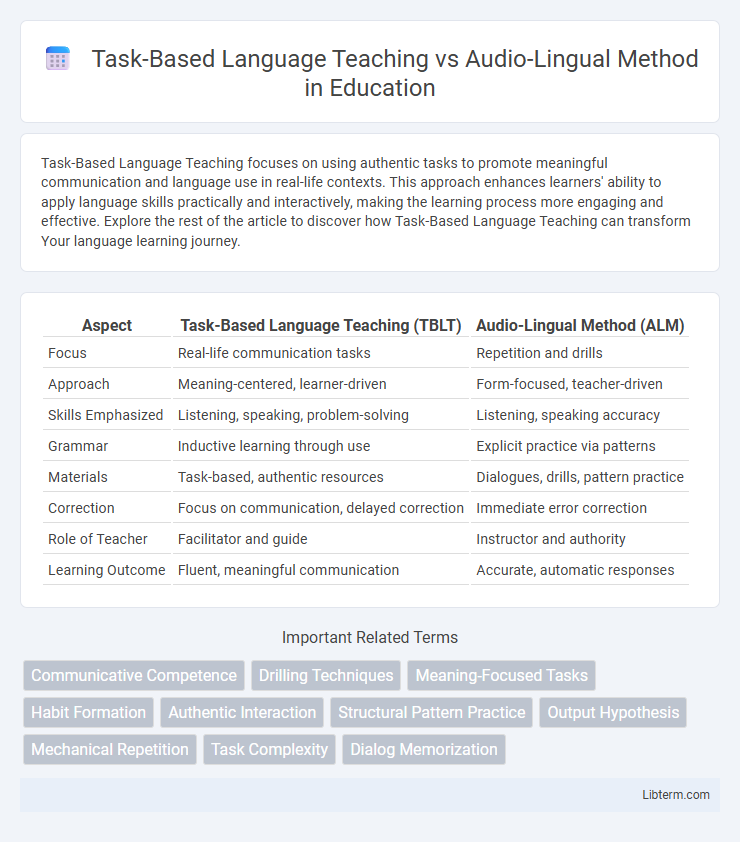Task-Based Language Teaching focuses on using authentic tasks to promote meaningful communication and language use in real-life contexts. This approach enhances learners' ability to apply language skills practically and interactively, making the learning process more engaging and effective. Explore the rest of the article to discover how Task-Based Language Teaching can transform Your language learning journey.
Table of Comparison
| Aspect | Task-Based Language Teaching (TBLT) | Audio-Lingual Method (ALM) |
|---|---|---|
| Focus | Real-life communication tasks | Repetition and drills |
| Approach | Meaning-centered, learner-driven | Form-focused, teacher-driven |
| Skills Emphasized | Listening, speaking, problem-solving | Listening, speaking accuracy |
| Grammar | Inductive learning through use | Explicit practice via patterns |
| Materials | Task-based, authentic resources | Dialogues, drills, pattern practice |
| Correction | Focus on communication, delayed correction | Immediate error correction |
| Role of Teacher | Facilitator and guide | Instructor and authority |
| Learning Outcome | Fluent, meaningful communication | Accurate, automatic responses |
Introduction to Language Teaching Methods
Task-Based Language Teaching (TBLT) emphasizes learning through meaningful tasks that simulate real-life communication, fostering practical language use and learner autonomy. The Audio-Lingual Method (ALM) relies heavily on repetitive drills and pattern practice to instill correct pronunciation and grammatical structure through habit formation. Both methods represent foundational approaches in language teaching, with TBLT centered on communicative competence and ALM on structural accuracy.
Overview of Task-Based Language Teaching (TBLT)
Task-Based Language Teaching (TBLT) centers on the completion of meaningful tasks that simulate real-life language use, promoting learner engagement and practical communication skills. Unlike the Audio-Lingual Method, which emphasizes repetitive drills and pattern practice, TBLT prioritizes authentic language interaction through problem-solving and information-gap activities. This approach enhances fluency and accuracy by encouraging learners to use language creatively and contextually.
Core Principles of the Audio-Lingual Method (ALM)
The Audio-Lingual Method (ALM) emphasizes repetitive drills, pattern practice, and immediate reinforcement to develop oral proficiency through habit formation, rejecting explicit grammar explanations. Its core principles include a focus on listening and speaking skills, use of dialogue memorization, and substitution drills to promote automatic language use. ALM operates on behaviorist theories, believing language learning is conditioned through stimulus-response actions reinforced by positive feedback.
Objectives and Goals: TBLT vs ALM
Task-Based Language Teaching (TBLT) prioritizes communication and practical language use through meaningful tasks that reflect real-life scenarios, aiming to develop learners' fluency and problem-solving skills in authentic contexts. The Audio-Lingual Method (ALM) focuses on habit formation and accurate pronunciation through repetitive drills and pattern practice, emphasizing grammatical structure and memorization. While TBLT targets functional language competence and learner autonomy, ALM aims for automatic language responses and structural mastery.
Classroom Activities and Techniques Compared
Task-Based Language Teaching (TBLT) emphasizes meaningful communication through real-life tasks, such as storytelling, role-plays, and problem-solving activities that promote authentic language use and learner interaction. In contrast, the Audio-Lingual Method relies on repetitive drills, pattern practice, and mimicry to reinforce grammatical structures and pronunciation in a controlled, structured classroom environment. While TBLT encourages creativity and spontaneous language production, the Audio-Lingual Method prioritizes habit formation through systematic repetition and immediate error correction.
Role of Grammar in TBLT and ALM
In Task-Based Language Teaching (TBLT), grammar is integrated contextually and learned implicitly through meaningful tasks, emphasizing communication over explicit rule instruction. The Audio-Lingual Method (ALM) prioritizes repetitive drills and pattern practice to reinforce grammatical structures explicitly and habitually. While TBLT focuses on fluency and functional use of grammar within authentic tasks, ALM seeks accuracy and automaticity through structured grammar exercises.
Teacher and Student Roles in Each Approach
Task-Based Language Teaching positions the teacher as a facilitator who designs meaningful tasks that promote real-life communication, encouraging students to actively engage and collaborate to complete those tasks. In contrast, the Audio-Lingual Method requires the teacher to act as a strict instructor who guides repetitive drills and pattern practice, with students responding passively and focusing on accurate pronunciation and habit formation. The shift in student roles highlights Task-Based learning's emphasis on autonomy and communicative competence, while the Audio-Lingual Method stresses mimicry and reinforcement through structured repetition.
Advantages and Challenges of TBLT
Task-Based Language Teaching (TBLT) emphasizes real-life communication and learner engagement through meaningful tasks, fostering practical language use and improving fluency. Advantages of TBLT include promoting learner autonomy and contextualized language practice, which can lead to greater retention and motivation. Challenges involve the need for careful task design, potential difficulty in assessing language accuracy, and greater demands on teacher creativity and adaptability compared to the Audio-Lingual Method's structured repetition and pattern drills.
Strengths and Limitations of the Audio-Lingual Method
The Audio-Lingual Method excels in developing students' listening and speaking skills through repetitive drills and pattern practice, promoting habit formation and immediate language use. Its structured approach is effective for beginners who need clear guidance and reinforcement of correct pronunciation and grammar. However, this method often lacks emphasis on communicative competence and creativity, potentially leading to learning that is rigid and devoid of meaningful language use in real-life contexts.
Conclusion: Choosing the Right Method for Language Learners
Task-Based Language Teaching (TBLT) emphasizes real-world communication and learner-centered activities, making it highly effective for developing practical language skills. The Audio-Lingual Method (ALM) relies on repetition and drills, which can be beneficial for beginners needing structured phonetic and grammatical practice. Selecting the right method depends on learner goals, proficiency level, and context, with TBLT favored for interactive competence and ALM suited for foundational accuracy.
Task-Based Language Teaching Infographic

 libterm.com
libterm.com